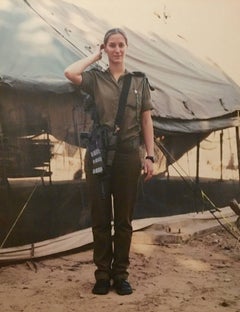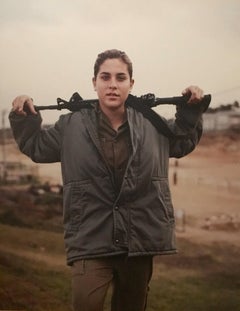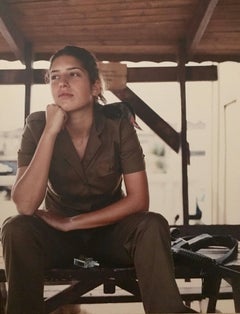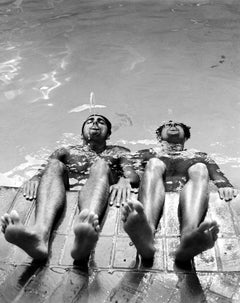Masonite Photography
to
3
Overall Width
to
Overall Height
to
3
3
3
2
2
1
1
1
1
1
1
1
1
1
3
3
1
3
1
1
3
Medium: Masonite
Artist: Ashkan Sahihi
WOMEN OF THE ISRAEL DEFENSE FORCES Large Photo NETA
Located in Surfside, FL
"Women of the IDF" Large Exhibition color Photograph
30 x 40 inches, mounted on masonite and laminated.
Edition of 4 + 2 artists proof. minor dings and bumps to edges Born in Tehran, Iran, Ashkan Sahihi moved with his family to West Germany at the age of seven. Although he began taking photographs as a teenager, Sahihi traces the beginning of his professional trajectory to New York in 1987, a thriving “pop culture metropolis” where he could do the kind of photography work that he wanted to do, exploring the underbelly of the society around him. Taking assignments from German publications such as the Süddeutsche Zeitung Magazine, Der Spiegel, Dummy and GEO, he photographed subjects like prisoners on death row, players in the hip-hop scene, and the downtown art scene of New York. Neither black nor white, an insider among outsiders, he found himself able to navigate spaces and dynamics that others might have had difficulty entering. He considered this both a privilege and an obligation – to visit these places and tell these stories. His success led to commissions from American publications as well, including the New York Times Magazine, the New Yorker, Rolling Stone, and Vogue.
Put off by the limitations of photojournalism (the expectation that he would illustrate the writer’s perspective rather than author a narrative of his own), Sahihi began to embark on independent, highly compact conceptual series. His main goal in these series has been to drive forward public discourse on topics he believes have not provoked enough or the right kind of discussion: drugs, gender in the media, women in the military, etc. His portraits draw on a familiar visual language – often seated subjects before a neutral backdrop – but push the viewer to feel and think about entirely new things. Although he constantly challenges the comfort level of both the viewer and the subject, Sahihi never removes himself from the line of fire; all of his work requires the artist to immerse himself in uncomfortable situations and challenge his own emotional fortitude.
Photographic Series
In the “Face Series”, latex-gloved hands manipulate the subjects’ features, stretching, pushing, squeezing, pinching at the whim of external direction – from the artist? The customer? The public? The “Hypnosis Series” comprises 8 portraits of hypnotized subjects each experiencing a single emotion, e.g. helplessness, withholding/anger, or regret. In a society that rewards the suppression of such naked emotion, the purity of these depictions is arresting.
In 2006, Sahihi photographed himself in the homes and with the families of six ex-girlfriends and one ex-wife, imposing himself more or less awkwardly on the constellations that emerged after he had exited their lives (“Exes Series”).
For Sahihi’s most well-known work, the “Drug Series,” he convinced 11 non–drug users to consume a particular drug, then took their portraits over the course of their trips. The series was born out of Sahihi’s frustration with the hypocrisy of the political conversation about drugs in the United States. “By attempting to present an objective image of drug use, the artist addresses the cultural politics that allow our society to simultaneously glamorize the ‘drug look’ in fashion magazines and the entertainment industry and meanwhile turn a blind eye to the complicated, and vast, problem of drug abuse.” Sahihi has exhibited this series at MoMA PS1 New York in 2001, in Dresden in 2008, and alongside his installation “100 Million in Ready Cash."
Sahihi’s dense explorations through small photographic series include “Women of the IDF," portraits of female Israeli soldiers...
Category
Early 2000s Masonite Photography
Materials
Masonite
WOMEN OF THE IDF Large color Photograph LITAL
Located in Surfside, FL
"Women of the IDF" Large Exhibition color Photograph
30 x 40 inches, mounted on masonite and laminated.
Edition of 4 + 2 artists proof. minor dings and bumps to edges Born in Tehran, Iran, Ashkan Sahihi moved with his family to West Germany at the age of seven. Although he began taking photographs as a teenager, Sahihi traces the beginning of his professional trajectory to New York in 1987, a thriving “pop culture metropolis” where he could do the kind of photography work that he wanted to do, exploring the underbelly of the society around him. Taking assignments from German publications such as the Süddeutsche Zeitung Magazine, Der Spiegel, Dummy and GEO, he photographed subjects like prisoners on death row, players in the hip-hop scene, and the downtown art scene of New York. Neither black nor white, an insider among outsiders, he found himself able to navigate spaces and dynamics that others might have had difficulty entering. He considered this both a privilege and an obligation – to visit these places and tell these stories. His success led to commissions from American publications as well, including the New York Times Magazine, the New Yorker, Rolling Stone, and Vogue.
Put off by the limitations of photojournalism (the expectation that he would illustrate the writer’s perspective rather than author a narrative of his own), Sahihi began to embark on independent, highly compact conceptual series. His main goal in these series has been to drive forward public discourse on topics he believes have not provoked enough or the right kind of discussion: drugs, gender in the media, women in the military, etc. His portraits draw on a familiar visual language – often seated subjects before a neutral backdrop – but push the viewer to feel and think about entirely new things. Although he constantly challenges the comfort level of both the viewer and the subject, Sahihi never removes himself from the line of fire; all of his work requires the artist to immerse himself in uncomfortable situations and challenge his own emotional fortitude.
Photographic Series
In the “Face Series”, latex-gloved hands manipulate the subjects’ features, stretching, pushing, squeezing, pinching at the whim of external direction – from the artist? The customer? The public? The “Hypnosis Series” comprises 8 portraits of hypnotized subjects each experiencing a single emotion, e.g. helplessness, withholding/anger, or regret. In a society that rewards the suppression of such naked emotion, the purity of these depictions is arresting.
In 2006, Sahihi photographed himself in the homes and with the families of six ex-girlfriends and one ex-wife, imposing himself more or less awkwardly on the constellations that emerged after he had exited their lives (“Exes Series”).
For Sahihi’s most well-known work, the “Drug Series,” he convinced 11 non–drug users to consume a particular drug, then took their portraits over the course of their trips. The series was born out of Sahihi’s frustration with the hypocrisy of the political conversation about drugs in the United States. “By attempting to present an objective image of drug use, the artist addresses the cultural politics that allow our society to simultaneously glamorize the ‘drug look’ in fashion magazines and the entertainment industry and meanwhile turn a blind eye to the complicated, and vast, problem of drug abuse.” Sahihi has exhibited this series at MoMA PS1 New York in 2001, in Dresden in 2008, and alongside his installation “100 Million in Ready Cash."
Sahihi’s dense explorations through small photographic series include “Women of the IDF," portraits of female Israeli soldiers...
Category
Early 2000s Masonite Photography
Materials
Masonite
Large Color Photograph "Women of the IDF" Ashkan Sahihi
Located in Surfside, FL
"Women of the IDF" Large Exhibition color Photograph
30 x 40 inches, mounted on masonite and laminated.
Edition of 4 + 2 artists proof. minor dings and bumps to edges Born in Tehran, Iran, Ashkan Sahihi moved with his family to West Germany at the age of seven. Although he began taking photographs as a teenager, Sahihi traces the beginning of his professional trajectory to New York in 1987, a thriving “pop culture metropolis” where he could do the kind of photography work that he wanted to do, exploring the underbelly of the society around him. Taking assignments from German publications such as the Süddeutsche Zeitung Magazine, Der Spiegel, Dummy and GEO, he photographed subjects like prisoners on death row, players in the hip-hop scene, and the downtown art scene of New York. Neither black nor white, an insider among outsiders, he found himself able to navigate spaces and dynamics that others might have had difficulty entering. He considered this both a privilege and an obligation – to visit these places and tell these stories. His success led to commissions from American publications as well, including the New York Times Magazine, the New Yorker, Rolling Stone, and Vogue.
Put off by the limitations of photojournalism (the expectation that he would illustrate the writer’s perspective rather than author a narrative of his own), Sahihi began to embark on independent, highly compact conceptual series. His main goal in these series has been to drive forward public discourse on topics he believes have not provoked enough or the right kind of discussion: drugs, gender in the media, women in the military, etc. His portraits draw on a familiar visual language – often seated subjects before a neutral backdrop – but push the viewer to feel and think about entirely new things. Although he constantly challenges the comfort level of both the viewer and the subject, Sahihi never removes himself from the line of fire; all of his work requires the artist to immerse himself in uncomfortable situations and challenge his own emotional fortitude.
Photographic Series
In the “Face Series”, latex-gloved hands manipulate the subjects’ features, stretching, pushing, squeezing, pinching at the whim of external direction – from the artist? The customer? The public? The “Hypnosis Series” comprises 8 portraits of hypnotized subjects each experiencing a single emotion, e.g. helplessness, withholding/anger, or regret. In a society that rewards the suppression of such naked emotion, the purity of these depictions is arresting.
In 2006, Sahihi photographed himself in the homes and with the families of six ex-girlfriends and one ex-wife, imposing himself more or less awkwardly on the constellations that emerged after he had exited their lives (“Exes Series”).
For Sahihi’s most well-known work, the “Drug Series,” he convinced 11 non–drug users to consume a particular drug, then took their portraits over the course of their trips. The series was born out of Sahihi’s frustration with the hypocrisy of the political conversation about drugs in the United States. “By attempting to present an objective image of drug use, the artist addresses the cultural politics that allow our society to simultaneously glamorize the ‘drug look’ in fashion magazines and the entertainment industry and meanwhile turn a blind eye to the complicated, and vast, problem of drug abuse.” Sahihi has exhibited this series at MoMA PS1 New York in 2001, in Dresden in 2008, and alongside his installation “100 Million in Ready Cash."
Sahihi’s dense explorations through small photographic series include “Women of the IDF," portraits of female Israeli soldiers...
Category
Early 2000s Masonite Photography
Materials
Laminate, Masonite
Related Items
Buckham Twins, Chateau Marmont
Located in Hudson, NY
Listing is for UNFRAMED print. Inquire within for framing.
Edition 1 of 15.
If the exhibition piece is sold or the customer orders a different print size, the photograph is produced upon purchase. Please allow two weeks for production.
Shipping time depends on method of shipping.
Price is subject to availability. The Robin Rice Gallery reserves the right to adjust this price depending on the current edition of the photograph.
In her new exhibition Churilla draws from her years spent as a swimmer, lifeguard, and athlete to capture the forgotten freedom and exuberance of days of youth spent on the water. Viva la Vida is a mix of timeless portraits and candid photographs "I’ve always been drawn to the water- now my art, my sense of athleticism, freedom and oasis have merged in a way", says Churilla. Her nod to iconic photographers from the past, such as Edward Weston, and Herbert List, is apparent in her portrait work.
In another Christian & Nathan Fletcher is in the midst of a surf crusade off the coast of Islamorada, Florida. Christian pioneered a new revolution in surfing style...
Category
1990s Contemporary Masonite Photography
Materials
Archival Pigment
Kate Moss 1993, Paradise Island Bahamas, Original Print Custom Framed
By Herb Ritts
Located in London, GB
For the 1994 Pirelli Calendar shot on the Paradise Island in the Bahamas, photographer Herb Ritts set out to capture in a series of nudes what he called “the gentle innocence” of Kat...
Category
1990s Contemporary Masonite Photography
Materials
Archival Paper, C Print, Photographic Paper, Photographic Film, Wood, Glass
$6,116
H 15.75 in W 10.63 in D 1.58 in
Nan Goldin Supreme set of 2 skateboard decks (Nan Goldin Supreme)
By Nan Goldin
Located in NEW YORK, NY
Nan Goldin Supreme Skateboard Decks, 2018 (set of 2):
– Misty and Jimmy Paulette in a taxi, (NYC 1991)
– Nan as a Dominatrix (Cambridge MA 1978)
Set of 2 limited edition Nan Goldin ...
Category
21st Century and Contemporary Street Art Masonite Photography
Materials
Wood, Offset
Girls in the Windows
By Ormond Gigli
Located in Lenox, MA
Photograph is hand-signed and editioned by the artist and comes directly from the artist's studio. It is available in additional sizes. It is available framed or unframed. Featured price includes existing framing. Contact us for more information.
Girls in the Windows...
Category
1960s Masonite Photography
Materials
Archival Pigment
Chefs's Last Supper - Portrait of 13 Michelin-starred Chefs - Framed Print
Located in London, GB
'Last supper' of 13 Michelin-starred Chefs...
John Reardon is particularly associated with his portraits of chefs for the Observer Food Monthly (UK) for which this commission based o...
Category
Early 2000s Contemporary Masonite Photography
Materials
Glass, Wood, Photographic Film, Archival Ink, Archival Paper, Photograph...
$9,786 Sale Price
20% Off
H 81 in W 127 in D 4 in
La Dama de la Plaza by James Sparshatt - A portrait of joy in life and cigars
Located in Coltishall, GB
A lady of pure joy… dancing in the Plaza de la Revolucion on May 1st.
The Spirit of the Revolution series documents the generation of Cubans that saw the dramatic changes of 1959 as...
Category
21st Century and Contemporary Other Art Style Masonite Photography
Materials
Wood, Silver Gelatin
$1,080
H 23 in W 22 in D 1 in
Kick Start
Located in Saint Louis, MO
With his multimedia portraits, Moroccan artist Hassan Hajjaj thrives in a space between cultures, traditions, mediums, and artistic movements. The subjects of his photography range f...
Category
Early 2000s Masonite Photography
Materials
Wood, Lambda
IGGY POP - FROM THE ALBUM COVER SOLDIER 1980, STUDIO PORTRAIT (1979)
Located in London, GB
IGGY POP - FROM THE ALBUM COVER SOLDIER 1980, STUDIO PORTRAIT (1979), 1979
Archival Pigment Print, Framed
Image size 30 x 30 cm
Frame: 55 x 45.5 cm
© Brian Griffin
"I remember this...
Category
1970s Performance Masonite Photography
Materials
Wood, Glass, Photographic Film, Photographic Paper, Color, Archival Pigment
$4,757
H 21.66 in W 17.92 in D 1.58 in
Tupac Shakur
Located in New York, NY
Homage to the late great musician Tupac Shakur. Images. Lyrics from his songs. Not framed. Acrylic paint on sheet music wheat pasted to wood panel. ...
Category
2010s Conceptual Masonite Photography
Materials
Wood, Mixed Media
Odd 1 Out
Located in Saint Louis, MO
With his multimedia portraits, Moroccan artist Hassan Hajjaj thrives in a space between cultures, traditions, mediums, and artistic movements. The subjects of his photography range f...
Category
Early 2000s Masonite Photography
Materials
Wood, C Print
Kanariepiet (Odd Stories) - Polaroid, Contemporary, Women
Located in Morongo Valley, CA
Kanariepiet (Odd Stories)
2/25, 2014
digital print mounted on mdf (15x11cm - 0,8 mm), matt coating
hand signed by the artist on the back.
-- Part of Carmen De Vos' solo show Odd St...
Category
2010s Contemporary Masonite Photography
Materials
Color, Digital, Polaroid, Wood, Archival Paper
$355
H 5.91 in W 4.45 in D 0.32 in
Vigilant by Monica Denevan. Photograph - Burma. Lower body with tattoo and sword
Located in Coltishall, GB
Vigilant by Monica Denevan - Photography, Silver Gelatin Print with Wooden Frame
Burma 2009
The legs of a young man showing tradional Burmese tattoos and carrying a sword.
The Ir...
Category
21st Century and Contemporary Contemporary Masonite Photography
Materials
Paper, Silver Gelatin, Glass, Wood
Monica DenevanVigilant by Monica Denevan. Photograph - Burma. Lower body with tattoo and sword, 2009
$1,834
H 25 in W 24 in D 0.5 in
Masonite photography for sale on 1stDibs.
Find a wide variety of authentic Masonite photography available on 1stDibs. While artists have worked in this medium across a range of time periods, art made with this material during the 21st Century is especially popular. There are many well-known artists whose body of work includes ceramic sculptures. Popular artists on 1stDibs associated with pieces like this include Ashkan Sahihi, and Steve Joester. Frequently made by artists working in the Contemporary, all of these pieces for sale are unique and many will draw the attention of guests in your home. Not every interior allows for large Masonite photography, so small editions measuring 0.1 inches across are also available




